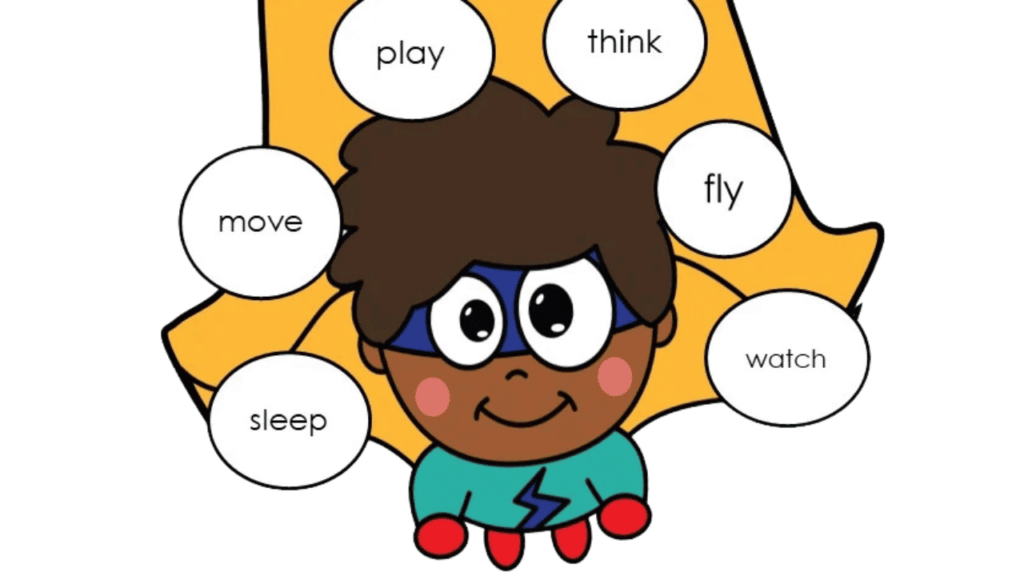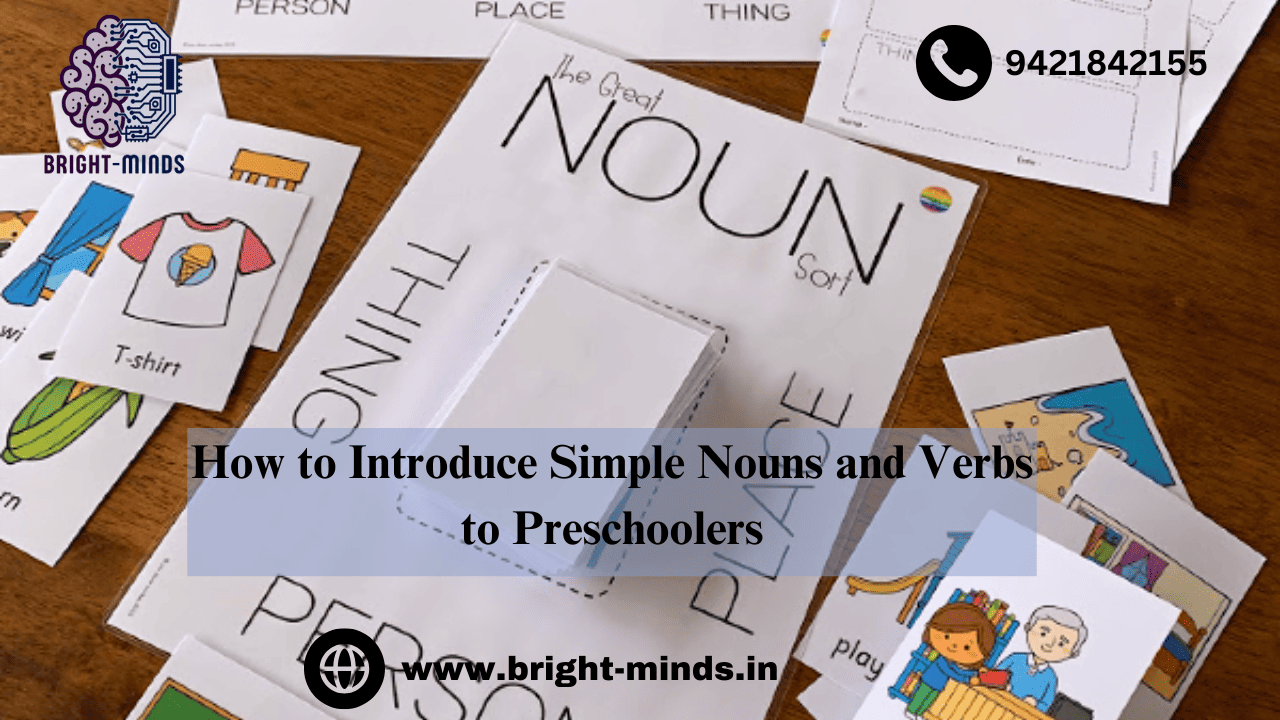Introduction
A crucial component of young children’s early development is exposing them to the fundamentals of language, such as nouns and verbs. Effective communication requires a grasp of these two speech components, which serve as the foundation for sentence construction. You may prepare toddlers for success in reading and writing by teaching them about nouns and verbs in an interesting and enjoyable way.
Why Teach Nouns and Verbs to Preschoolers?
The fundamental building blocks of language are nouns and verbs. They must be introduced to toddlers at an early age for the following reasons:
- Nouns: A noun is an individual, location, object, or concept. Children’s vocabulary grows as a result of their ability to classify the people and things in their environment through noun recognition.
- Verbs: A verb is a state of being or an action. Children who comprehend verbs are able to explain actions, which gives their speech more life and significance.
- Simple sentences, which are essential for communication, are formed when nouns and verbs work together. Early exposure to these ideas enhances children’s capacity for self-expression, language comprehension, and writing.
Starting with Nouns and Verbs: What to Teach First?

Knowing which nouns and verbs to introduce first is useful before delving into particular teaching strategies. This is a fundamental guide:
- Nouns: Begin with everyday, concrete nouns. These include things like toys, animals, food, and family members that kids may readily relate to.
- Noun examples include “cat,” “dog,” “ball,” “car,” “mom,” and “apple.”
- Verbs: Start with basic action verbs. Select verbs that kids can actively do and that are simple to illustrate.
- Verbs include things like run, jump, eat, play, sing, and read.
Creative Ways to Introduce Nouns and Verbs to Preschoolers
1. Picture Flashcards
Flashcards are a great way to teach verbs and nouns alike. Nouns (like pictures of people, animals, or food) and verbs (like visuals of running or jumping) can be represented with simple graphics. Here’s how to make the most of flashcards:
- Noun flashcards: Say, “This is a cat,” while displaying an image of an animal, such as a cat. An animal is a cat. Encourage your youngster to mimic your actions.
- Verb flashcards: Say, “This is jumping,” while displaying an image of a person leaping. Leaping is an action. Encourage repetition once more.
- Engaging Game: Lay out a variety of verb and noun flashcards on the ground. Request that your youngster select a card and pronounce the word out loud. Ask them to act after a couple of rounds.
2. Storytime with Nouns and Verbs
Teaching nouns and verbs to kids through storytelling is a fun and natural approach. There are a lot of easily recognized nouns and verbs in children’s novels. You can highlight these sections of speech during storytime in the following ways:
- Select the Correct Books: Select picture books with straightforward language that uses distinct nouns and verbs. Books like Eric Carle’s The Very Hungry Caterpillar and Bill Martin Jr.’s Brown Bear, Brown Bear, What Do You See? are excellent examples.
- Point Out Verbs and Nouns: Take a moment while reading to identify the verbs and nouns. You could say, for instance, “The caterpillar is a noun because it’s an object” in The Very Hungry Caterpillar. Since the caterpillar uses the verb “eat,” it is a verb.
- Pose Questions: Have your child name the nouns and verbs on a page once they have read it. For instance, “Can you indicate the apple? The caterpillar is doing what?
3. Noun and Verb Sorting Activities
Preschoolers can learn to discriminate between nouns and verbs through sorting exercises. This is an easy task you can complete at home:
- Make a Board for Sorting: On a piece of paper, draw two sizable boxes, or use different containers. Put “Nouns” in one box and “Verbs” in the other.
- Get the cards ready: Make a deck of cards that have images and words that stand in for nouns (cat, book, tree) and verbs (run, jump, sleep).
- Arrange the cards: Have your youngster place the cards in the appropriate boxes. A few cards that could fall into either category, such “eat” (verb) and “apple” (noun), can make this more difficult.
4. Action Songs and Rhymes
Because they make learning enjoyable and engaging, songs and rhymes are excellent tools for teaching verbs. Kids can easily connect with verbs because many classic songs and rhymes include basic motions. Here are some examples:
- The well-known song “Head, Shoulders, Knees, and Toes” reinforces verbs like “touch,” “bend,” and “move” by encouraging kids to sing and move simultaneously.
- “If You’re Happy and You Know It” contains a number of verbs that kids can act out, such as “clap your hands” and “stomp your feet.”
- Write Your Own Music: Use verbs like “jump,” “run,” “twirl,” or “sing” to create a short song. Together with your child, sing it, and as you sing, have them do the movements.
5. Noun and Verb Playdough Activities
Playdough promotes creativity and experiential learning, making it a great medium for teaching nouns and verbs. Try this enjoyable activity:
- Noun Creation: Assist your child in creating simple nouns, including objects (ball, automobile) or animals (dog, cat), using playdough. Explain that these are nouns since they are things as you make.
- Verb Acting: Encourage your child to use their playdough creations to act out verbs after you’ve created a few nouns. “Can your playdough dog run?” is one example. Can you hop with your playdough cat? They can physically do the verbs through this exercise.
6. Interactive Noun and Verb Games
Games make learning feel like a fun challenge and are a great way to reinforce the understanding of nouns and verbs. Here are some games you can try:
- Simon Says: This classic game is perfect for teaching verbs. Say, “Simon says, ‘Jump!’” or “Simon says, ‘Run in place!’” Let your child perform the actions, reinforcing the verbs.
- Noun and Verb Charades: Write down nouns and verbs on slips of paper. Take turns picking a slip and acting out the noun or verb. For example, if the card says “run,” you can run around, and your child can guess the verb.
- Freeze Dance: Let your kids dance while music plays. Call out a verb (such as “jump,” “clap,” or “twirl”) when the music stops. Learning verbs becomes an engaging and hands-on experience when your child is required to carry out the action.
7. Daily Conversations and Labeling
Make use of verbs and nouns in your everyday speech. The notions are reinforced by this continuous exposure. Here’s how:
- Noun Labeling: Give each item you come across a name as you go about your day. For instance, “Observe the vehicle. Since a car is an object, it is a noun.
- Verbal Exchanges: As you perform actions, discuss them. For instance, you could say, “I’m eating the apple,” while you’re eating. Since eating is something I do, it is a verb. Ask your youngster to join you in repeating the sentence.
The Role of Positive Reinforcement
Positive reinforcement is crucial when your youngster starts to comprehend verbs and nouns. Give your child praise for correctly recognizing or utilizing nouns and verbs, and encourage them when they attempt to use them in novel ways. Little victories boost self-esteem and enthusiasm for learning a language.
Challenges and Tips for Overcoming Them
- Challenge: At initially, some kids could confuse nouns with verbs.
- Solution: Use a lot of repetition and keep things basic. Provide precise illustrations and serve as a model for the usage of nouns and verbs in sentences.
- Challenge: Young toddlers might not always be able to recall or tell nouns from verbs.
- Solution: To strengthen learning, use interactive exercises and visual aids. To maintain their interest, make it enjoyable and interactive.
Conclusion
- Preschoolers enjoy the exciting and fulfilling process of learning simple words and verbs. You can aid young learners in understanding these fundamental speech components by utilizing imaginative exercises, games, songs, and casual discussions. Your child will be on their way to developing a solid foundation for literacy and communication skills if you are patient, consistent, and supportive.
- You can set the stage for your child’s future success in reading and writing by implementing these strategies into your everyday routine and making learning about nouns and verbs enjoyable and significant!
Also Read:
https://bright-minds.in/unlocking-word-meaning-for-class-ukg-english-to-hindi/

